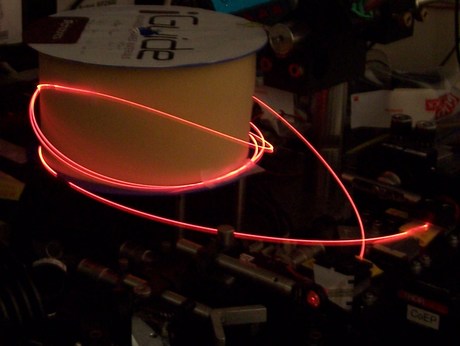An amazing laser

A team of Australian researchers has developed a revolutionary new type of optical fibre laser that is cost-effective to produce, portable and can be tuned to operate over a wide range of the infrared spectrum. Potential applications include remote sensing of organic molecules such as greenhouse gases and medical diagnostics.
Lasers generally work at one wavelength, but this new laser can be tuned into a wide range of wavelengths over the infrared light spectrum, according to lead author and postdoctoral fellow at the University of Adelaide Dr Ori Henderson-Sapir. “In fact,” he said, “this laser has the largest wavelength tuning ever demonstrated by a fibre laser, and reaches further into the mid-infrared than ever achieved before from a fibre laser operating at room temperature.”
The research was a joint effort between Macquarie University and the University of Adelaide with support from the Australian Research Council and the South Australian Premier’s Research and Industry Fund.
Project leader David Ottaway is an Associate Professor at the School of Physical Sciences and the Institute for Photonics and Advanced Sensing at the University of Adelaide. He explained that the obvious and immediate application of this new laser is in detecting the “molecular fingerprints” of organic molecules, such as hydrocarbon gases, which absorb light at varied frequencies. “By changing the wavelength of our laser, we can measure the light absorption patterns of different chemicals with a high degree of sensitivity,” he said.
Remote sensing of greenhouse gases, including ethane and methane, at considerable distances will enable researchers to focus on areas of concern involving various emission sources from agriculture and industry.
The new laser also has potential applications in the medical field. The analysis of trace gases in exhaled breath can be used to diagnose diseases such as diabetes, but the bulk and expense of the requisite equipment has limited its use in the past.
Macquarie University’s Associate Professor Stuart Jackson explained: “The main limitation to date with laser detection of these gases has been the lack of suitable and affordable light sources that can produce enough energy and operate at the correct part of the light spectrum.”
Using a less cumbersome and more cost-effective optical fibre, the new laser has the potential to become a very useful sensing tool in medical diagnostics with “incredible potential for scanning for a range of gases with a high level of sensitivity”, according to Dr Ottaway.
“We hope this laser will open up opportunities for lasers in the mid-infrared in a similar manner that titanium doped sapphire lasers revolutionised lasers operating in the visible and near-infrared,” he said.
This research was published in the journal Optics Letters.
Chewing gum can shed microplastics into saliva, study finds
Most of the microplastics detached from gum within the first two minutes of chewing, with the act...
Widespread applications of shake flask off-gas analysis across biotechnology
Despite the emergence of more sophisticated bioreactor systems, shake flasks continue to play a...
Scientists may finally know what makes Mars red
The water-rich iron mineral ferrihydrite may be the main culprit behind Mars's reddish dust,...




